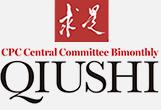Striving to Provide Strong S&T Support for Modern Agricultural Development
At its third plenary session, the 20th CPC Central Committee rolled out systematic plans to deepen S&T structural reform, introducing major initiatives to stimulate S&T innovation. We must thoroughly implement the Central Committee’s decisions and plans, ensuring self-reliance and strength in agricultural S&T, giving greater priority to agricultural S&T development, and deepening agricultural S&T structural reform.
We should strengthen the dual drivers of S&T advancement and institutional reform, optimize efforts to organize academic disciplines, nurture talent, enhance platforms, and allocate funds, and provide the strong S&T support needed to drive modern agricultural development.
Developing world-class agricultural disciplines with Chinese features that are well-aligned with S&T innovation needs
We need to focus on the global frontiers of agricultural disciplines and modern agricultural development needs and adapt to the rapid advancement of cutting-edge technologies such as information technology, artificial intelligence, and synthetic biology.
To this end, we must establish a mechanism for creating and adjusting agriculture-related disciplines that is guided by S&T development and national strategic needs. We should make extraordinary moves to plan for disciplines and majors that are in urgent demand, taking steps to make them more forward-looking, adaptable, and targeted.
Efforts should be redoubled to develop disciplines related to basic research, interdisciplinary frontiers, and key areas. In universities and research institutes with the right conditions, we should establish urgently needed majors in key areas such as food security, ecological advancement, smart agriculture, nutrition and health, and rural development.
Additionally, we should make plans to develop majors in a group of emerging agriculture-related fields, such as green and low-carbon development, multifunctional agriculture, ecological restoration, forest-based wellness and care, wetland protection, and human living environment governance.
Improving guidance and training for agricultural S&T talent to ensure an ample supply of human resources for innovation
Human resources are the primary resource and the most vibrant and dynamic factor in innovation. To advance S&T innovation, we need to cultivate a large, well-structured team of high-quality innovative talent. In 2022, 87,700 personnel were employed in China's agricultural research institutions, and a total of 489,800 agri-tech promotion workers were working at various levels of the agricultural sector. We must do more to enhance the team of agricultural S&T personnel in order to boost its stability and optimize its structure. The S&T talent systems for agriculture and rural areas also need to be refined.
We should make a major push to train outstanding scientific research talent, launch a talent attraction scheme for agriculture and rural areas, with a focus on outstanding talent in frontier fields such as artificial intelligence and synthetic biology, and move faster to cultivate science strategists, first-class scientists, and innovation teams.
We should implement the S&T specialist dispatch system, taking targeted steps to ensure that S&T personnel are well-matched to specific agricultural and rural needs and that talent chains are aligned with industrial chains, so as to fully tap the vitality of talent for agricultural and rural modernization.
We need to give greater play to self-taught experts, veteran growers, rural makers, and high-caliber farmers in the innovation and application of agricultural S&T and strive to build a force of agricultural S&T innovators with a focus on agricultural universities and research institutes.
Developing agricultural research platforms and enhancing our capacity for S&T innovation
To accelerate agricultural S&T innovation, we need to enhance the overall effectiveness of the innovation system by leveraging S&T platforms, promote stronger coordination between the central and local levels, and strive to eliminate bottlenecks within the system.
To boost China’s strength in strategic agricultural S&T, we should refine the system of national laboratories and better define the roles and layout of our national research institutions, advanced-level research universities, and leading high-tech enterprises.
From a vertical standpoint, we need to clarify the core missions of agricultural research institutions at the central, provincial, and prefectural and city levels and leverage the advantages of different entities to create an integrated system built on seamless interconnection and strong complementarity.
Horizontally speaking, we should specify the primary responsibilities and core business of agricultural universities, research institutes, and tech enterprises and define the roles of various innovation entities to enhance the overall efficiency of agricultural S&T innovation.
With national laboratories taking the lead, we should bring together existing agricultural S&T innovation and application platforms concerning basic work, fundamental research, key technological innovations, and integration, so as to create a comprehensive and efficient system of platforms that will provide the foundational support needed to achieve greater self-reliance and strength in agricultural and rural S&T.
Encouraging dedication to science and tapping a powerful force for innovation
Given the long-term, foundational, and public-interest nature of agricultural research, it is essential to strengthen the CPC's overall leadership over agricultural S&T work. We should leverage the guiding role of CPC organizations to effectively organize the scientific community and plan agricultural research work from a holistic perspective.
We need to establish an agricultural S&T talent evaluation system focused on innovative capacity, quality, practical results, and contribution and refine the mechanisms for discovering, selecting, and cultivating young innovative talent, in order to tap the innovative drive and potential of agricultural S&T personnel.
We must strengthen ethical standards and address academic misconduct, encourage agricultural S&T personnel to carry forward the exemplary traditions of many of the older generation of agricultural scientists like Yuan Longping, and ensure that research innovations are effectively applied to practical farming.
Editor: Zhang Xian
























